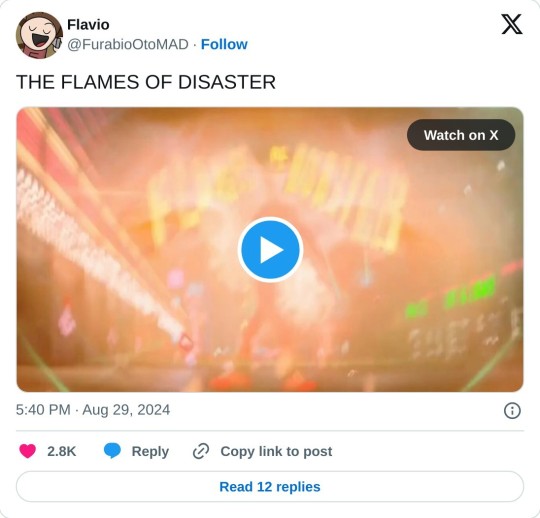#The citizens of London on September 2nd 1666:
Explore tagged Tumblr posts
Text
THE 🔥FLAMES🔥OF DISASTER⁉️⁉️‼️
Here’s a link to the original tweet by @//FurabioOtoMAD on Twitter :D!
They also uploaded the video onto YouTube! XDDDDDDD
Go check it out!

youtube
#sonicmovie3hype#sonicmovie3#sonicmovie#sonic movie 2#knuckles show#wade whipple#WHAT THE WADE??!!! THIS IS PEAK!!!🔥🔥🔥🔥#the internet is healing#why yes i do listen to real music LMFAOOO#this is the best fucking thing I’ve seen all week#welcome back ytpmvs#the knuckles show isn’t bad you guys are just mean#from officer brainfart to warrior#luv you wade whipple#now kids… that’s what we call ✨character development✨#silver in sonic 4 after hearing wade say “the flames of disaster”#The citizens of London on September 2nd 1666:#if you’re not british or don’t live in the uk and you have no idea what I’m referring to?#google is free and right there waiting for you#When I’m seeing an orphanage burn to the ground:#when I burn my house down :
6 notes
·
View notes
Video
2nd September 1666, around 2am in Pudding Lane in London at the bakery of the house of Thomas Farriner, a fire erupts. London was seeing the last cases from the worst outbreak of the plague that century with 100,000 of its citizens, a quarter of London’s population dead in 18 months. As the city slept, little did they know of what new disaster lay in wait slowly growing around them, and what destruction the ‘Great Fire of London’ would cause. Lasting until September 6th, the fire ultimately destroyed 80% of the medieval city of London, alongside 13,200 houses, 87 churches, and the medieval cathedral of St. Pauls. The fire’s spread and destruction is recorded in the diary of Samuel Pepys, a firsthand account of everyday life during the 17th century. Pepys himself was the first person to inform the king of the fire, according to his diary entry for this day. Historians disagree but one of the aftermaths of the fire was the rebuilding of London, where the plague never returned, is it possible that the fire storm wiped out the fleas and the rats that carried them, as well as the crowded medieval streets that had become their breeding ground since the first outbreak in 1348? Other epidemics in London would take its place, but yersinia pestis never again was able to gain a foothold in the city. Thank you for watching, if you would like more tales of the strange, dark and macabre alongside original artwork inspired by gothic history, please follow @ofgrave.concern #thursdaytales #macabrehistory #darkhistory #macabre #17thcentury #17thcenturyhistory #stuarthistory #houseofstuart #charlesii #historicalstories #historicalstory #englishhistory #britishhistory #thisdayinhistory #onthisdayinhistory #historyofbritain #restorationperiod #londonhistory #historytales #talesfromhistory #interestinghistory #greatfireoflondon #greatfireoflondon1666 #thegreatfireoflondon #greatplagueoflondon #historyoflondon #puddinglane #historicalevents #historyvideo #historyvideos https://www.instagram.com/p/CTU0aIlnHvH/?utm_medium=tumblr
#thursdaytales#macabrehistory#darkhistory#macabre#17thcentury#17thcenturyhistory#stuarthistory#houseofstuart#charlesii#historicalstories#historicalstory#englishhistory#britishhistory#thisdayinhistory#onthisdayinhistory#historyofbritain#restorationperiod#londonhistory#historytales#talesfromhistory#interestinghistory#greatfireoflondon#greatfireoflondon1666#thegreatfireoflondon#greatplagueoflondon#historyoflondon#puddinglane#historicalevents#historyvideo#historyvideos
0 notes
Photo

Plague and Fire 2nd September 1666, around 2am in Pudding Lane in London at the bakery of the house of Thomas Farriner, a fire erupts. London was seeing the last cases from the worst outbreak of the plague that century with 100,000 of its citizens, a quarter of London’s population dead in 18 months. As the city slept, little did they know of what new disaster lay in wait slowly growing around them, and what destruction the ‘Great Fire of London’ would cause. Lasting until September 6th, the fire ultimately destroyed 80% of the medieval city of London, alongside 13,200 houses, 87 churches, and the medieval cathedral of St. Pauls. The fire’s spread and destruction is recorded in the diary of Samuel Pepys, a firsthand account of everyday life during the 17th century. Pepys himself was the first person to inform the king of the fire, according to his diary entry for this day. Historians disagree but one of the aftermaths of the fire was the rebuilding of London, where the plague never returned, is it possible that the fire storm wiped out the fleas and the rats that carried them, as well as the crowded medieval streets that had become their breeding ground since the first outbreak in 1348? Other epidemics in London would take its place, but yersinia pestis never again was able to gain a foothold in the city. All art shown is inspired by London’s dark years of 1665 to 1666. They are for sale on the website. See link in bio. #greatfireoflondon #greatfireoflondon1666 #london #londonhistory #plague #plaguedoctor #17thcentury #17thcenturystyle #londonhistory #macabreart #macabre #macabreartist #macabrestyle #17thcenturyart #historyart #strangehistory #plagueart #history #historic #historical #historylovers #historygeek #plaguedoctorart #samuelpepys https://www.instagram.com/p/CEwTQIOA7VX/?igshid=i6qvjsabw8n
#greatfireoflondon#greatfireoflondon1666#london#londonhistory#plague#plaguedoctor#17thcentury#17thcenturystyle#macabreart#macabre#macabreartist#macabrestyle#17thcenturyart#historyart#strangehistory#plagueart#history#historic#historical#historylovers#historygeek#plaguedoctorart#samuelpepys
0 notes